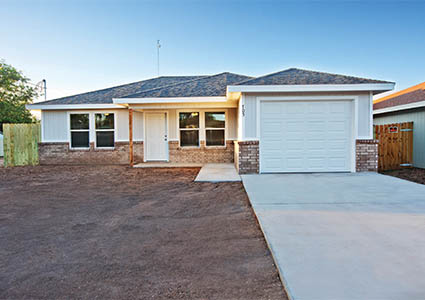How Galilee CDC is empowering residents and tackling homelessness with affordable housing
Based in San Angelo, Texas, Galilee CDC (Galilee) is a not-for-profit organization providing affordable housing options for residents on low to moderate incomes. Having impacted the lives of more than 200 families across the Concho Valley, Galilee is on a mission to aid homelessness, revitalize declining communities, and support economic growth.
As the Community Housing Development Organization (CHDO) for the city of San Angelo, Galilee operates several community programs to support low-income residents with affordable home ownership and rental properties, as well as light rehabilitation and repairs. To learn more about Galilee’s operations and its latest developments, we sit down with Stephanie Hamby, Executive Director, and Carlos Cruz, Rehabilitation Manager. 
Improving lives
“Galilee was established in 2000 by the late Rev. Floyd Crider, who recognized the need for decent, affordable housing,” begins Stephanie. “Floyd witnessed families living in poorly constructed housing across San Angelo’s low-income neighborhoods and was determined to reverse the impact of physical and moral deterioration in the community.
“We started out as a contractor for the first ten years or so, before branching into remodels and renovations. In 2012, we started a new program called Helping Hands, which recreated the old ‘Christmas in April’ concept where hundreds of volunteers undertake repairs for low-income senior homeowners to ensure their homes are safe, secure, and weatherproof. This program is primarily conducted on a blitz weekend in April, with over 400 volunteers working on more than 35 homes.
“Today, the business operates with three divisions: new home construction, remodels, and rentals,” she continues. “The new home division constructs brand-new homes in San Angelo and its surrounding rural communities, whereas the remodel division runs five different remodeling programs. Our new projects, apartments, and communities fall under our rental section, where we often work with other local organizations to obtain, build, and manage these properties.”
Turning to the company’s geographic footprint, Stephanie says: “Although we’re based in San Angelo, our typical geographic reach extends to a radius of around 60 miles. Our operations are largely funded by city HOME funds, state programs, grants, and local authorities, with the goal of providing affordable housing for every person under 80 percent of the income limit set by the US Department of Housing and Urban Development (HUD). As we receive very little direct government funding, we’re strict on the income limit criteria to ensure our services reach those people in lower income brackets.
“Homelessness is a deep-rooted issue across all of America and there is insufficient affordable housing available, especially in our communities. Every one of our employees has a genuine passion to help people; to prevent homelessness and support low-income neighborhoods that have started to deteriorate.
“We try to provide options for everyone, regardless of budget or accessibility issues. We do everything under our control to identify programs or other funding opportunities that help us to improve people’s lives. All our remodels are free of charge, funded through several grants and state programs, and in the rental sector, our rates are set well below market standards. While there is a charge for our new homes, we work closely with other programs to aid in lowering the cost.
 “By collaborating with other organizations, we can do so much more than we can as an individual group,” she suggests. “One of our longstanding partnerships is with the Housing Authority, for instance, and we’re currently closing out a joint project to fully remodel eight-unit apartments specifically set aside for homeless veterans.”
“By collaborating with other organizations, we can do so much more than we can as an individual group,” she suggests. “One of our longstanding partnerships is with the Housing Authority, for instance, and we’re currently closing out a joint project to fully remodel eight-unit apartments specifically set aside for homeless veterans.”
Strategic partnerships
Carlos adds: “Most people hear about our work through word of mouth. Many people are not used to seeing contractors in their small communities, so they approach us to learn more about what we are doing. Once they learn more, they might apply for support themselves or recommend us to others, and in this way, we’re promoting our services just by engaging with the communities in which we operate.”
To try and get ahead of the curve in terms of future generations of homelessness, Galilee is creating housing specifically designed for young adults. “We’ve recently purchased an eight-unit apartment building, which will be fully refurbished for a target audience of young adults between the ages of 18 and 30,” Stephanie reveals.
“We find that homelessness often has a ripple effect on multiple generations and we’re striving to end this cycle. With the category of 18-to-30-year-olds leaving school or the foster care system, these individuals are susceptible to homelessness or ‘couch surfing’, but by thinking upstream, we can provide good quality, affordable apartments to combat these potential issues. We’re thinking further than the current generation, working to both revitalize and stabilize communities not just for today, but for ten years down the line.”
With this in mind, Carlos turns the conversation to the future of Galilee. “It goes without saying that our goal is to continue providing more housing,” he states. “Specifically, we want to get ahead of the curve by building more housing for young adults. However, land is in demand, meaning we must be creative about building methods and techniques by reusing existing buildings rather than constructing new homes.”
Stephanie concludes: “San Angelo currently does not have an operational homeless shelter, so we’d love to be part of building a new center. We’ll continue to identify strategic partnerships with other local organizations and perhaps educating or inspiring other non-profits to establish similar unique schemes in our community and beyond.”
